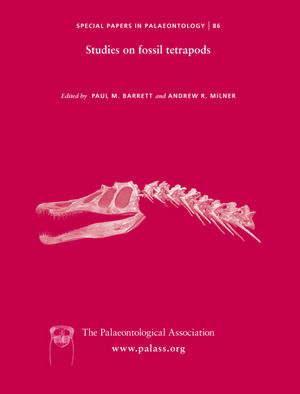Reg. Charity No. 1168330

This contribution reviews all the material that can be assigned to Barilium dawsoni (Lydekker). This includes the holotype, which is described in its entirety for the first time, and a number of referred specimens. The species is re-diagnosed on the basis of a number of unique characters and character combinations. Barilium is a robust (c. 10 m long) styracosternan iguanodontian ornithopod. Posterior dorsal and sacral vertebrae have tall, thick and inclined neural spines that were flanked by a lattice of ossified tendons and their centra bear thick keels. The ilium has a distinctive shape, and the sacrum (comprising one sacrodorsal, five true sacrals and one sacrocaudal) is characterized by a prominent, discontinuous midline keel. Caudal vertebrae have 1–4 slope downward, away from the sacrum, and are subrectangular; posterior caudal centra are angular-sided and strongly amphicoelous. The forelimb has a very robust radius and ulna that are bound firmly together distally against a single, co-ossified carpal block. Pronation ⁄ supination of the forelimb was controlled by motion at a synovial joint between the proximal ends of the radius and ulna. Digit 1 of the manus is completely fused to the carpus, and the pollex ungual is uniquely short, blunt and laterally compressed and has a shallow vertical trough running down its lateral surface from apex to base. Barilium was probably an obligate quadruped and coexisted with an anatomically similar, but smaller and more lightly built, iguanodontian (Hypselospinus fittoni). Upper Jurassic and Lower Cretaceous iguanodontians are often represented by robust ⁄ large and gracile ⁄ small osteological (and taxonomic) pairs. A recent review has proposed two new taxonomic names for the material considered in this paper: a new generic name for the holotype and a new binomial for a referred specimen (NHMUK R3788). Both proposals are judged to be invalid: the new generic name suggested for the holotype is a junior objective synonym of Barilium dawsoni (Lydekker); the criteria proposed for the recognition of a new binomial for material herein to B. cf. dawsoni are suggested to be in error.